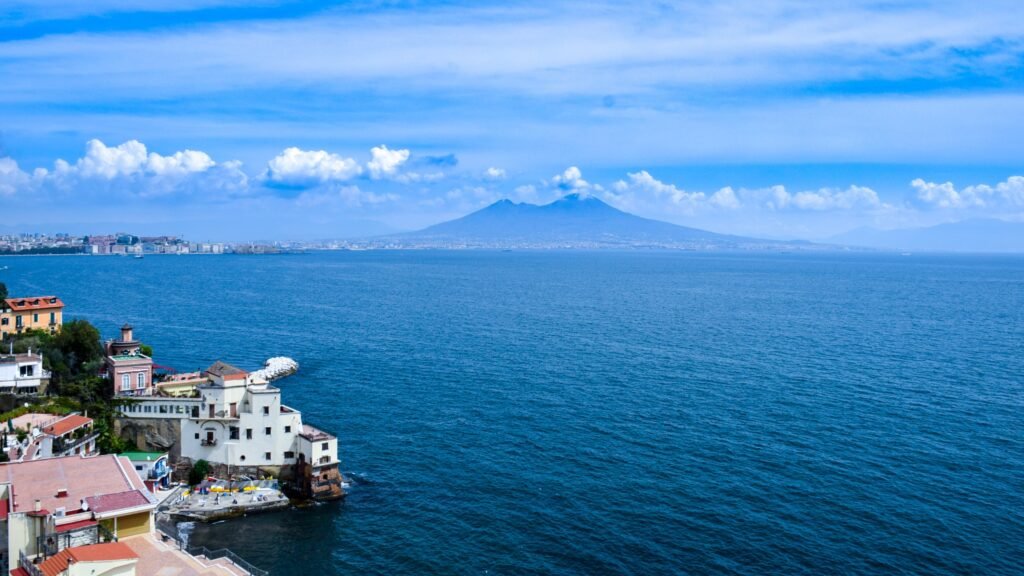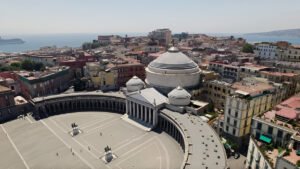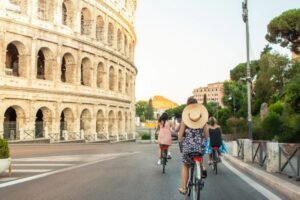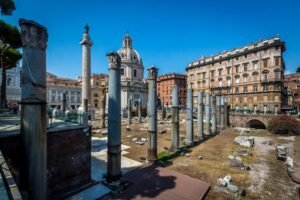8 Best things to do in Naples, Italia | Discover the top Picks

These are my top seven things to do in Naples, Italia.
Naples is Italy’s third-largest city and is mostly famous for being located only five and a half miles from the infamous Mount Vesuvius—or as locals call it, Vesuvio. Many people visit Naples because it’s a great jumping-off point for places such as the Amalfi Coast, the ruins of Pompeii, the island of Capri, and many other destinations for day trips besides Napoli itself.
Napoli actually sometimes has a reputation for being a bit of a dirty, dangerous city and overall unremarkable, but let’s see why that assumption is essentially wrong.
So let’s start my top picks with 7 things to do in Naples.
The sunset atop Castel Sant’Elmo
Number one on this list is to watch the sunset atop Castel Sant’Elmo. Castel Sant’Elmo is actually a fortress—an impregnable one at that—that was built back in the 13th century and is located atop Vomero Hill, which is the highest point in all of Napoli. This makes it a fantastic viewpoint.
From the top of Castel Sant’Elmo, you get unparalleled, panoramic views of the surrounding area, including, of course, Vesuvio, the Bay of Naples, the Sorrentine Peninsula, the island of Capri, and the island of Ischia. If you time it perfectly, you can watch an unforgettable sunset as the sun dips below the horizon.
Because Napoli faces westward, you get the perfect sunset view as the sun sets behind the island of Ischia, right between the mountains and the island of Procida in the foreground, making it an unforgettable experience.
The sunset I’ve ever seen in my life—probably. Now, to get to the top of Castel Sant’Elmo, there are two main ways to do it. The easiest (and laziest, but hey, no shame if this is your choice) is by taking the funicula or funiculare, which you can catch from Monte Santo Station.
The way I did it, though, which was a lot of fun, was from the Quartieri Spagnoli (the Spanish Quarters). There’s actually a walking path called the Pedamentina San Martino. This walkway is a little steep, so you might start to huff and puff a bit, but it’s really relaxing and scenic.
You’ll be away from the busyness of the Spanish Quarters, and as you climb higher towards Vomero Hill, you’ll enjoy beautiful, open views of the Bay of Naples and Vesuvius before reaching the ultimate destination: Castel Sant’Elmo.
And of course, one of the best things about this place? Entry to Castel Sant’Elmo is only two and a half euros, so it’s incredibly cheap and definitely worth it.
Eating pizza in Napoli
Number two on this list is a must for obvious reasons: eating pizza in Napoli.
As you probably know, Napoli is the birthplace of pizza. This is where the Neapolitan style of pizza originated—a pizza with a thin, soft crust (not a cracker crust) and a center that’s almost soupy, like a pie.
People in Napoli take their pizza very seriously. The city even has regulations to ensure the pizza is made correctly, preserving the art of crafting the perfect Neapolitan pizza.
The pizzas here are also incredibly cheap. Don’t pay more than five or six euros for an entire pizza—anything higher and you’re likely getting ripped off. Some of the best, most delicious pizzerias serve massive pizzas (twice the size of your head!) for as little as three to six euros.
Now, for recommendations:
- My favorite pizza—the most delicious pizza I’ve ever had in my life.
- Matteo, located conveniently right across the street.
- L’Antica Pizzeria da Michele, the most famous pizzeria in Napoli.
If you want to see more about the pizzas and other food I tried in Napoli, check out my food Blog. I Discuss everything I ate in detail, and I guarantee it’ll make you hungry—just like I get every time I Rewrite it. It’s a great way to see more context, reviews, and details about the delicious pizza you absolutely have to try when visiting Italy. Specifically Napoli.
Sightseeing
Number three on this list is to go on a bit of a sightseeing tour that I’ve created for you, featuring the main highlights in the historic center of Naples. Many of these locations are relatively close to each other, or you can at least create a logical path connecting them. You can definitely see all of these in a day—or even less, depending on how much time you want to spend—but be prepared to walk a decent amount.
Here are the locations I recommend for number three:The first location, or our first highlight, is Piazza del Plebiscito. This is, in my opinion, the main heart of Naples. It features a very grand, open space where you can see lots of people and hear music being played.
You’ll also see a half-circle of grand pillars and columns in the main plaza. It’s a great place to orient yourself and take in an impressive architectural and cultural landmark in Naples.
Located just nearby is the Galleria Umberto I—I think that’s how it’s pronounced. This is actually a shopping arcade, but for me, what stands out is:
- The exterior design, which is very grand and beautiful.
- As you walk up the steps to enter the Galleria, you’ll see a massive dome with ornate designs surrounding it.
The shops? Meh. If you want to shop, go for it, but it’s definitely worth visiting just to admire the design and the beautiful Italian architecture of the Galleria.
While you’re in the area, you’ll likely spot the Castel Nuovo from a distance. It’s definitely worth observing and maybe walking closer to for a better look at the exterior. However, I personally wouldn’t recommend touring the inside—I’ve heard it’s a bit underwhelming. Still, it’s a stunning medieval castle that adds to the charm and character of the historic center of Naples and is definitely worth seeing.
Located a bit north of this area is my favorite church in Naples, the Chiesa del Gesù Nuovo.
The Chiesa del Gesù Nuovo actually has a very interesting exterior—slightly worn, with rough, not-so-pristine stone—that will definitely catch your eye. But once you step inside, it will blow you away. The church opens up into a grandiose space with a beautifully detailed floor, and, of course, the ceilings, which feature stunning paintings, vibrant colors, and accents of gold and silver.
It’s absolutely striking, and if you haven’t visited any churches in Europe before, this is the perfect introduction. If you’ve already seen other iconic churches like St. Peter’s Basilica, it might not compare in sheer scale, but in my personal opinion, it’s still among the most impressive churches in Europe and Italy. Definitely a must-visit.
And we mustn’t forget: located right nearby the Chiesa del Gesù Nuovo is the Chiostro di Santa Chiara. This is actually part of a church, but for me, the real highlight is the cloister and garden.
The cloister features a lovely open courtyard with an inner garden area beautifully accented by white, blue, and yellow tiles on the pillars and benches, reminiscent of the Italian islands and the Amalfi Coast. It’s a peaceful area, perfect for a quiet stroll. Surrounding the outer rim of the cloister are walls adorned with stunning religious paintings and depictions of historical events, making it a fascinating and serene spot to explore.
This location is also conveniently close to some of the other sites in the historic center of Napoli. Napoli, Naples. Napoli Naples? Why not merge them into “Napoli” like I do?
You may have noticed I left out a pretty significant site from this little highlight tour of the historic center. That’s because it deserves its own spot at Next one number foure.
Palazzo Reale di Napoli or the Royal Palace of Naples
This place warrants more time than the other stops on this tour because it’s vast, grand, and packed with things to see and do. I’d recommend setting aside at least two hours—perhaps even half a day—to fully explore it, which might make it hard to fit into a fast-paced sightseeing schedule like the one we just discussed.
The Royal Palace itself was constructed back in the 1600s. It’s located right across from the Piazza del Plebiscito, so you can’t miss it. The palace completely exceeded my expectations. I thought it might just be another cool historic site, but the moment you step inside, you’ll be amazed at the opulence and grandeur of the lifestyle the kings, queens, and royal family experienced on a daily basis.
Some of my highlights included the grand staircase room, a massive, white, marble masterpiece with stunning design. I also really enjoyed the court theater, the throne room, and the chapel, all located within the palace itself.
The Royal Palace is definitely worth dedicating some time to—whether you include it as part of your sightseeing tour of other nearby locations or make it a standalone half-day activity before exploring more of Napoli.
Lungomare di Napoli and the Castel dell’Ovo
Number five combines two attractions because they’re located in the same area and can easily be done together: the Lungomare di Napoli and the Castel dell’Ovo (Egg Castle).
If you know some Latin, you might recognize “ovo” means egg (shoutout to healthcare workers who studied Latin!). Anyway, the Lungomare di Napoli is a perfect activity to pair with a visit to the Royal Palace or a historic center sightseeing tour, as it’s located just a bit west and south of those main highlights.
The Lungomare is Naples’ seafront promenade—a beautiful waterfront area where you can take in the sea breeze, enjoy amazing views, and admire various statues, monuments, and architectural touches along the way.
While walking along the Lungomare, you’ll inevitably spot the Castel dell’Ovo. This seaside castle, one of the oldest buildings in Naples, was originally constructed in the first century BC—yes, over 2,000 years ago!
The castle gets its name from an old legend: it’s said that the Castel dell’Ovo and the city of Napoli are connected like an egg and its shell. If the shell (the castle) were to crack or break, the entire city of Naples (the egg) would fall. Thankfully, the castle remains intact to this day, and Naples is still standing strong.
The Castel dell’Ovo is a striking sight, perched on the coast. Even better, it’s free to enter, making it an excellent option for exploring on a budget. The castle isn’t too large, but it offers fantastic views of the sea and the surrounding city.
Of Naples, you can see the cannons, the Bay of Naples, and of course, you guessed it, Vesuvius in the background. Another view of Vesuvius from this nice, beautiful little opening in the bay, a little harbor area in Napoli.
The soul and essence
Now, number six is to wander down, explore, and just sort of get lost in some of Napoli’s most iconic streets. And why are they iconic to me? These capture the soul and essence of Naples and the Neapolitans as well.
These streets might not be as pristine and magical as some of those areas on Italian islands or maybe some of the northern or central Italian cities. These streets are gritty, raw, and unapologetically beautiful. Small little alleys tucked away, with motorbikes scooting by, balconies with people airing off their clothes.
The buildings might not be as pristine, but they’re a little raw and weathered. You might see some graffiti here and there, but there will be lots of sights, smells, and locals hanging out in the plazas, talking and drinking. This, for me, is the true essence of Napoli.
Here are the streets where I think you can really capture it the best. Number one is Via de Tribulani. Now, Via de Tribulani, coincidentally, is actually called Pizza Street because there’s a high concentration of great pizza places, such as Gino etotosovillo, which we talked about earlier—my favorite pizza in the whole city. There are so many restaurants here, so many little plazas and shops, and great little places to wander in and check out. You can see locals watching the soccer games here during the night.
And it really has that magical feeling we were talking about earlier. Now, the second street I recommend is actually a collection of streets called Spakanapoli, literally translating to “splits” or “splitting Naples.” This can be easily viewed from above but is harder to find on a map because, again, it’s a collection of streets.
From the Chiesa del Gesù Nuovo or Piazza del Gesù Nuovo, which we were talking about earlier—the really beautiful church—you can head a bit east or come from the west, heading down the Via San Vallio de lebre.
It’s long, with lots of shops, and has all the characteristics, qualities, and atmosphere we talked about for these real authentic Neapolitan streets. And of course, this is more of a little alley or connecting street, not as big as the others.
It’s going to be Via San Gregorio Armeno, or commonly referred to as Christmas Street. Now, Christmas Street—trust me, it’s a lot easier to call it Christmas Street too—is actually running north and south, so it intersects with Via de Tribulani and is very noticeable because there are many different vendors and artisans selling these little statuettes outside of their stores.
It’s really lively during Christmas, apparently, and there are lots of different art pieces on display to see. There are also plenty of souvenirs to buy, including the carnicello or the lucky horn, which you’ll see everywhere in Naples. It would be hard to miss. This is a really unique place to walk around, maybe do some shopping, while experiencing Naples with that same atmosphere we talked about thus far.
Shopping street right by Piazza
Alright, and finally, we are at the end of our list, with number seven being my honorable mentions. You know, this is a top seven list, but it’s really more like 15 or 16 when everything is included. So let’s get started with the first honorable mention, which is going to be Via Toledo Street.
Via Toledo is the main shopping street right by Piazza del Plebiscito, running north from the historic center of Naples. But I think it’s a little bit touristy, with a lot of name-brand clothing. It’s definitely worth checking out, but I would rather check out the iconic atmospheric streets we talked about earlier.
You can do lots of shopping here, get some street food, and there are restaurants, cafes, and espresso bars—a good place to wander around. But again, don’t trade it for the iconic gritty streets we talked about before.
Now, the next honorable mention is going to be the Duomo or the Naples Cathedral. This is another iconic church in Naples, and the outside is more beautiful than the Gesù Nuovo. It’s a very pristine, beautiful, white, sharp-angled church, and when you go inside, it’s
Definitely impressive as well. So, if you have church fever and want to check out some more beautiful churches in Naples, definitely check out this one as well.
Now, the next one is an honorable mention, but maybe you should consider it a little bit higher, which is to check out some Neapolitan pastries. Number one is pogliatella. This is my favorite that I had in Napoli. It has a delicious sort of sweet ricotta filling— not too sweet, really delicious, with great texture and taste. You can find these everywhere. Another one, maybe not specific to Naples, is the croissant or the cornetti—perfect for cappuccino.
Now, the one you should definitely not try—sorry, everybody, got to be real here—is the babà. This is a pastry that’s like a sponge cake, literally soaked with rum, soggy, and tastes straight like alcohol. Not for me. If you want to try it, go for it, just don’t say I recommended it to you because I recommend you do not try it, unless you just want a fun experience to be like, “That was pretty disgusting.”
Another really popular thing, which I didn’t have a chance to do, is to visit the catacombs of Napoli. One of the ones you should visit is the Catacombe di San Gennaro. These are underground cemeteries. The other one you should definitely consider visiting if you’re interested in the activity is the Catacombs of San Gaudioso. Those are the two you should consider if this activity interests you.
And last but not least for my honorable mentions is to visit the Royal Palace and Gardens of Capodimonte. Now, if you want to visit another royal palace a little bit further away from the center of the city, this is a great place to do so. It’s a beautiful building, more of a nice orangey-red, and has a lovely garden park to explore. It’s maybe a little bit quieter too, away from the heart and center of Naples.
Mount Vesuvius
One of the most well-known and dangerous volcanoes in the world is located in close proximity and in plain sight of more than 5 million people. Centered only 13.7 km east-southeast of the city center of Naples, the towering edifice of Mount Vesuvius, which I have ranked as the third most potentially dangerous volcano on the planet, ranks only behind Taal in the Philippines and Krakatoa in Indonesia.
Just by looking at this volcano, you can easily see that it has a highly explosive and destructive history, with a large 1,000 ft deep and 2,000 m wide summit crater formed by a powerful 1906 eruption and a steep-walled caldera remnant marking the remains of the Mount Som volcano, which immediately preceded Mount Vesuvius.
However, the reason why Mount Vesuvius is so well ingrained in world history is due to its well-documented and destructive eruption in 79 CE, which famously wiped out the ancient cities of Pompeii and Herculaneum, leading to the deaths of 16,000 people, and also marking history’s first scientifically documented volcanic eruption.
Approximately one-third of those who perished in that eruption were killed by roof collapses and ejected boulders of rock. The rest were killed by superheated 500 to 1,000°C pyroclastic flows and surges, which incinerated an area of 310 square kilometers. These pyroclastic flows were, in essence, a hurricane for speed—walls of suffocating gases and fragments of rock, up to the size of cars, which killed anyone who encountered them within seconds.
This pyroclastic flow reached Pompeii within only a few minutes of its generation, reaching up to 15.9 km away, including portions of the modern city of Naples. And this is not Vesuvius’s only deadly eruption, aided by the fact that since the end of the last ice age, Vesuvius has produced the ninth-highest number of highly explosive eruptions of VEI4 or larger, with a total of 13 deadly eruptions that have led to the deaths of a combined 23,211 people.
We can only hope that Vesuvius does not erupt again for a long time. During the 2,300-year-long written record of its eruptions, it has erupted about once every 45 years on average. However, This includes periods with longer gaps between eruptions of up to 350 years, along with periods where more frequent eruptions occurred, such as the 26 eruptions recorded between 1631 and 1944.
Since Vesuvius is currently undergoing an 80-year-long lack of eruptive activity, should we be immediately concerned? To this, I say no, not really, as Vesuvius has not only undergone longer periods with no eruptions but also existing scientific evidence suggests that the 1944 eruption marked the end of a short-term eruptive cycle.
In other words, it could be as much as another 1 to 2 centuries before the next eruption occurs. Also, not all of Vesuvius’s eruptions are truly catastrophic. While rare, Vesuvius has also produced completely non-explosive eruptions, which generated notable lava flows in the 9th century.
Now, here is a brief geologic history of Mount Vesuvius. Vesuvius is a subduction-related volcano created by the collision of the African plate underneath the Eurasian plate. While volcanism has been occurring around Vesuvius for up to 400,000 years, we only have a decent record of volcanism since 25,000 years ago.
At that time, an older volcano existed in the place of Mount Vesuvius, growing to a tall height that allowed occasional snow to fall on its edifice. However, this volcano, known as Mount Somma, would later be almost completely destroyed in an ultra-plinian eruption 17,000 years ago. It is at this point that the modern Vesuvius volcano began to grow.
Frequent volcanic eruptions of primarily basaltic, trachyandesite, and trachyte composition lavas and ash then grew the volcano, with a recognizable central cone being constructed over the following 7,000 years. Very few eruptions occurred, but those that did were more alkali-rich, with powerful eruptions following in 6940 and 2420 BCE.
The latter wiped out several regional Bronze Age settlements, causing people to flee on foot. Over the next 2,100 years, at least five additional eruptions took place, which were one to two orders of magnitude smaller than the aforementioned major eruptions.
Vesuvius then became more active once again around 200 BCE, with the following 900 years including destructive eruptions in 79, 203, 472, and 685. Eruptions then became smaller and less frequent for a time until, in 1631, a powerful and deadly Plinian eruption occurred, resulting in the deaths of 5,000 people and depositing 30 cm of ash in Naples.
A highly active phase continued for the next 413 years, with one notable eruption in 1794 producing a stunning 4-kilometer-high lava fountain. The last eruption ended in 1944, and Vesuvius has been fairly quiet ever since. However, it will one day eventually erupt again.
So, those are my top things to do in Naples, everybody. If you do these things, I am confident—I’ll bet money on it—that you will have the best possible time in Naples. This covers all the bases: you get the delicious food, you get to enjoy the amazing natural location in Naples, and you get to see the raw and authentic.
Gritty Naples that people say is the real Italy, which you don’t get maybe in some of these more pristine and manicured, almost like Disneyland locations, maybe like Florence, from what I’ve heard, or Venice. These are the real, authentic Southern Italy, everybody. Make sure you visit here and do these things.
Thank you, and that wraps up our 8 Best things to do in Naples, Italia | Discover the top Picks. Do you agree with the places we chose, or is there somewhere you visited that you feel should be on the list? leave us a comment.
You can find me on Instagram: @dreamytravelersofficial/.








